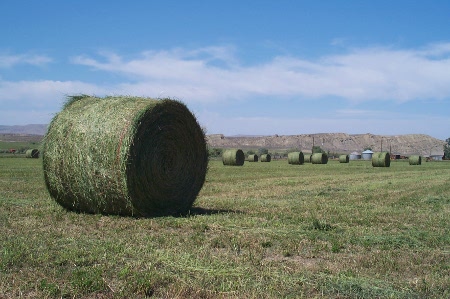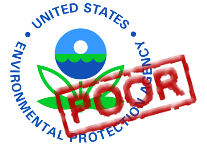How can the public trust government agencies to ensure the safety of GMOs if those agencies have a long track record of failure? USDA’s regulatory track record begs the question of whether it is a government “regulatory” agency or an industry group.
|
|
|||
|
According to a story published recently in the St. Louis Post-Dispatch, “Monsanto Co. asked the U.S. Supreme Court to review a lower court’s decision to ban the planting of genetically modified alfalfa until an environmental review is complete.” Monsanto is now the world’s leading agricultural biotechnology corporation and that spells bad news for small farmers. As many farmers have learned, they are not free from the watchful eye of the Big Brother, who, in this case, is Monsanto. German researchers have successfully transferred a fungal resisting gene found in bacteria and other plants into peas but as a result of high administrative costs and political uncertainty in Germany, they will continue field testing genetically modified peas in United States. Industry bias, lax scientific standards, exemption of food crops containing pesticides from registration requirements, and failure to independently monitor GM crops after approval, are among the regulatory problems exhibited by the EPA when it comes to regulating GMOs. In a world where sometimes it seems that our life is determined by someone or something else, it is refreshing to realize that your individual choice can and does make a profound difference. You can reduce environmental degradation by going vegetarian, or, at a minimum, by consuming less meat. Recently, a New York Times article exposed the practices of the ground beef industry and inadequacies in USDA’s oversight. The industry’s desire to cut costs and the failure of the regulatory agency to have and/or implement safety protocols, has, at times, resulted in dire consequence. When was the last time you heard that Russia’s policy is more enlightened and forward thinking than that of U.S. on any issue? The United States government consistently promotes its regulatory framework for genetically engineered organisms as comprehensive and strict. Is this a public relations maneuver, wishful thinking or the story of the emperor without clothes? Our friends a The Center For Food Safety have released an updated Shoppers Guide to Avoiding Genetically Engineered Foods. The guide is helpful because currently United States has no labeling requirements for foods and consumers have no way of knowing if the foods they eat contain or are likely made of genetically engineered ingredients.G A new breed of genetically engineered dandelions is currently in development and could be implemented in a number of industrial, chemical and pharmaceutical uses. Currently, transgenic dandelions are used to create dandelion-derived latex. Judge Jeffrey White of the Northern District of California ruled on September 21, 2009, that the U.S. Department of Agriculture’s deregulation of genetically engineered RoundUp Ready sugar beets in 2004 was unlawful. The USDA provides a number of exemptions for articles that it has determined do not pose a plant pest risk. One of such exemptions authorizes the introduction of certain regulated articles without a permit provided that USDA is notified in advance. Comments made by Cardinal Martino, as described more fully below, suggest to many that the Vatican has either endorsed the use of GMOs or, at a minimum, welcomed the idea of using GMOs as a way to address world hunger. The United States Department of Agriculture (”USDA” or “Agency”) requires that anyone desiring to import, transport interstate, or plant a regulated article must apply for a permit or make a notification to the Agency’s Animal and Plant Health Inspection Service (”APHIS”) that an introduction will be made. Under the Plant Protection Act (”PPA”) USDA requires that anyone desiring to import, transport interstate, or plant a “regulated article” must apply for a permit or make a notification to APHIS that an introduction will be made. The United States Department of Agriculture shares significant regulatory authority over GM crops with FDA and EPA. Transgenic, or genetically modified, plants are regulated by USDA’s Animal and Plant Health Inspection Service (”APHIS”) under the Plant Protection Act (”PPA”). The FDA’s regulatory approach thus focuses on the end product, rather than the process used to create genetically modified foods. In short, the FDA regards GM products as “generally regarded as safe,” (”GRAS”) and does not subject GM food products to food additive review. The Food and Drug Administration is the lead regulatory agency of food articles. It is in charge of ensuring the safety and effectiveness of food (other than meat), food additives, medical devices, drugs, veterinary drugs, cosmetics and genetically engineered food. Whole Foods announced that it is partnering with the Non-GMO Project to use the Project’s Product Verification Program (”PVP”) to certify Whole Foods’ private labeling food line as being free from genetically modified ingredients. A genetically engineered variety of soybean resistant to Asian rust will soon be widely available in West and Central Africa. TSCA provides the EPA with authority to regulate chemical substances which may present an unreasonable risk of injury to health or the environment during manufacture, processing, distribution in commerce, use, or disposal. TSCA applies to uses of substances that are not specifically covered by another statute, i.e., TSCA does not apply to pesticides, food, drugs or cosmetics. TSCA is therefore a “catch-all” or “gap-filler” statute. In the case of herbicide-tolerant crops, EPA establishes tolerances for the allowable amount of herbicide residues that may remain on the crop. Environmental Protection Agency's Role Under The Federal Insecticide, Fungicide, and Rodenticide ActEPA uses its authority under FIFRA to regulate plant incorporated protectants, or substances produced to control pests, both, to ensure that the production of such a pesticide in plants is safe for the environment, and to establish allowable levels of the pesticide in the food supply. |
|||
|
 |
|||












